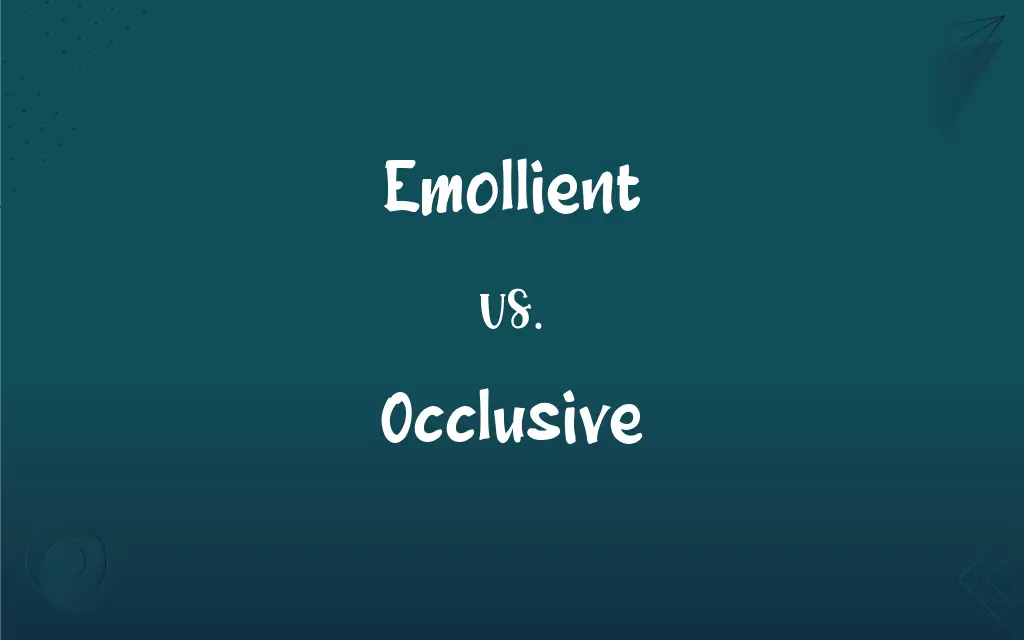Emollient vs. Occlusive: What's the Difference?
Edited by Aimie Carlson || By Janet White || Published on January 18, 2024
Emollients soften and smooth the skin by filling in gaps between skin cells, while occlusives create a barrier on the skin's surface to prevent moisture loss.

Key Differences
Emollients work by penetrating the skin to make it softer and more pliable, filling in gaps in the skin cells. Occlusives, however, form a protective layer on the skin’s surface to lock in moisture.
Emollients are often lighter in texture and easily absorbed into the skin, making them suitable for everyday use. Occlusives tend to be thicker and create a barrier on the skin, ideal for severely dry areas.
Common emollient ingredients include lanolin, ceramides, and fatty acids. Occlusives often contain ingredients like petroleum jelly, waxes, and silicones.
Emollients are best for general skin hydration and improving texture. Occlusives are more effective in preventing water loss, especially in dry, cold, or windy conditions.
Emollients are suitable for most skin types, including sensitive skin. Occlusives are particularly beneficial for very dry or chapped skin but may be too heavy for oily or acne-prone skin.
ADVERTISEMENT
Comparison Chart
Primary Function
Soften and smooth skin by filling gaps between cells
Form a barrier on skin to prevent moisture loss
Texture
Lighter, easily absorbed
Thicker, creates a protective layer
Common Ingredients
Lanolin, ceramides, fatty acids
Petroleum jelly, waxes, silicones
Usage
General hydration, texture improvement
Preventing water loss, protection in harsh conditions
Ideal for Skin Types
All, including sensitive skin
Very dry or chapped skin, not ideal for oily skin
ADVERTISEMENT
Emollient and Occlusive Definitions
Emollient
A moisturizer that fills in gaps between skin cells.
This emollient is excellent for smoothing out fine lines.
Occlusive
A skincare product that prevents water loss from the skin's surface.
She used an occlusive cream on her hands to lock in moisture.
Emollient
A substance that softens and moisturizes the skin.
She used an emollient cream to soothe her dry skin.
Occlusive
A topical product that seals in other skincare ingredients.
He applied an occlusive layer over his hydrating serum at night.
Emollient
A topical preparation used to soften the skin.
She applies an emollient balm to her lips every night.
Occlusive
A barrier-forming ingredient in moisturizers and balms.
The occlusive nature of petroleum jelly helps protect chapped lips.
Emollient
A skincare ingredient that helps to hydrate and smooth skin texture.
The emollient properties of the lotion made her skin feel supple and soft.
Occlusive
A heavy, protective moisturizer ideal for very dry skin.
For her cracked heels, an occlusive balm worked wonders.
Emollient
A product that improves skin elasticity and reduces roughness.
His dermatologist recommended an emollient for his rough, patchy skin.
Occlusive
A substance that forms a protective layer on the skin to trap moisture.
To combat dry winter skin, he used an occlusive ointment.
Emollient
Softening and soothing, especially to the skin.
Occlusive
Occluding or tending to occlude.
Emollient
Making less harsh or abrasive; mollifying
The emollient approach of a diplomatic mediator.
Occlusive
An oral or nasal stop.
Emollient
An agent that softens or soothes the skin.
Occlusive
That tends to occlude.
Emollient
An agent that assuages or mollifies.
Occlusive
(phonetics) A phoneme produced by obstructing airflow in the vocal tract, but not necessarily in the nasal tract.
Emollient
Something which softens or lubricates the skin; moisturizer.
Occlusive
(cosmetics) A product that forms a protective film and traps moisture against the skin.
Emollient
(figurative) Anything soothing the mind, or that makes something more acceptable.
Occlusive
A consonant produced by stopping the flow of air at some point and suddenly releasing it;
His stop consonants are too aspirated
Emollient
Moisturizing.
Occlusive
Tending to occlude
Emollient
(figurative) Soothing or mollifying.
Emollient
Softening; making supple; acting as an emollient.
Emollient
An external something or soothing application to allay irritation, soreness, etc.
Emollient
Toiletry consisting of any of various substances resembling cream that have a soothing and moisturizing effect when applied to the skin
Emollient
Having a softening or soothing effect especially to the skin
FAQs
What is an occlusive?
An occlusive is a skincare ingredient that forms a barrier to lock in moisture.
How do emollients benefit the skin?
Emollients hydrate the skin, improve texture, and increase elasticity.
Are emollients good for all skin types?
Yes, emollients are generally suitable for all skin types, including sensitive skin.
Should emollients be used daily?
Yes, emollients can be used daily as part of a regular skincare routine.
What is an emollient?
An emollient is a substance that moisturizes and softens the skin.
Can emollients heal dry skin?
Emollients can significantly improve dry skin by providing hydration and smoothing skin texture.
Can occlusives cause acne?
Occlusives can potentially cause acne in oily or acne-prone skin due to their heavy texture.
Are occlusives good for eczema?
Yes, occlusives are beneficial for eczema as they help to retain moisture in the skin.
How do occlusives work?
Occlusives work by forming a physical barrier on the skin's surface to prevent water loss.
What's the primary use of occlusives?
Occlusives are primarily used to prevent moisture loss and protect the skin from environmental factors.
Are occlusives only for winter?
While particularly beneficial in winter, occlusives can be used year-round for very dry skin.
Is petroleum jelly an occlusive?
Yes, petroleum jelly is a common example of an occlusive.
Can emollients be used on the lips?
Yes, emollients can be used to moisturize and soften the lips.
Are natural oils considered emollients?
Many natural oils, like coconut oil, function as emollients.
Do emollients clog pores?
Most emollients do not clog pores, but it's important to choose non-comedogenic products.
Should occlusives be the last step in skincare?
Typically, occlusives should be applied as the last step to seal in moisture and other skincare products.
Can occlusives help with cracked heels?
Yes, occlusives are effective in treating and protecting cracked heels.
Can occlusives be used on the face?
Occlusives can be used on the face, but should be chosen carefully, especially for oily or acne-prone skin.
Can I use emollients under makeup?
Yes, lightweight emollients can be used under makeup to keep the skin hydrated.
Do emollients help with wrinkles?
Emollients can help reduce the appearance of fine lines by keeping the skin hydrated.
About Author
Written by
Janet WhiteJanet White has been an esteemed writer and blogger for Difference Wiki. Holding a Master's degree in Science and Medical Journalism from the prestigious Boston University, she has consistently demonstrated her expertise and passion for her field. When she's not immersed in her work, Janet relishes her time exercising, delving into a good book, and cherishing moments with friends and family.
Edited by
Aimie CarlsonAimie Carlson, holding a master's degree in English literature, is a fervent English language enthusiast. She lends her writing talents to Difference Wiki, a prominent website that specializes in comparisons, offering readers insightful analyses that both captivate and inform.








































































